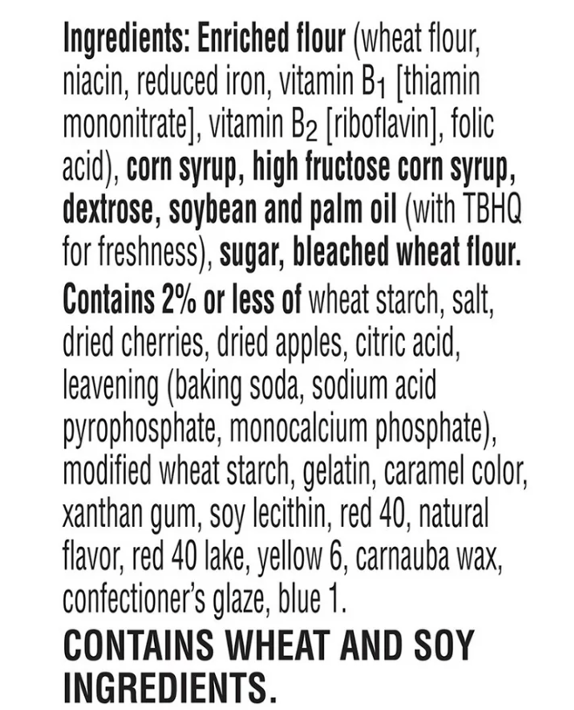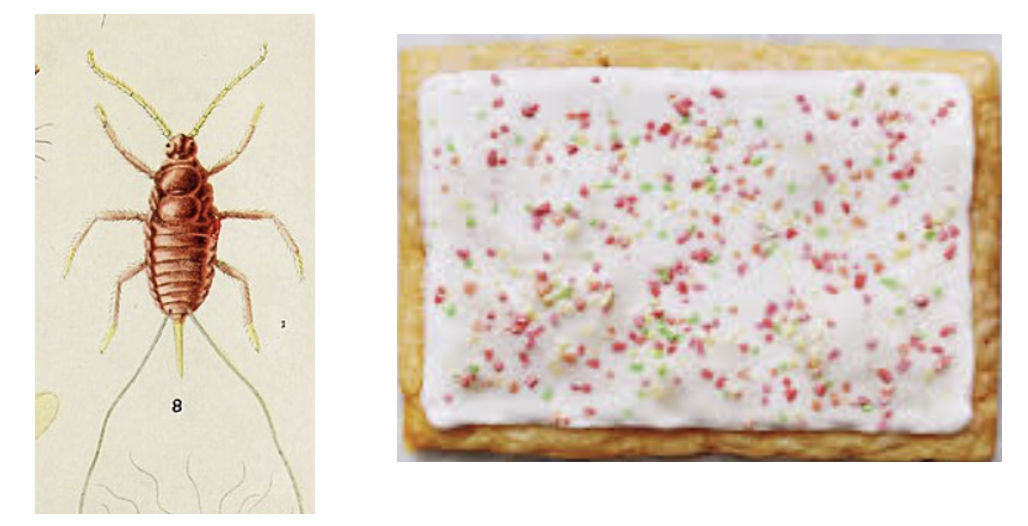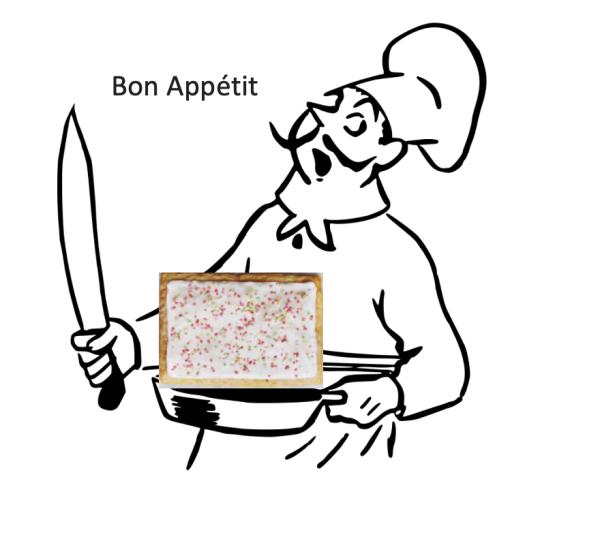When the natural vs. processed food debate gets going (as if it ever stopped) one of a number of foods inevitably gets brought into the conversation. Take your choice. Twinkies? For sure. Are they food? Let's save that for another day. Pop-Tarts, those tasty food-like delicacies, are also a perennial candidate in this debate, especially in ACSH articles (1).
Although I'm still a fan (except for the cinnamon ones, which are vile), I manage to avoid partaking, not because I think they will kill me, but so that my pants don't explode. Again.
Are Pop-Tarts FDA-approved killers, or do they just get a bad rap? Let's take a look at the ingredients list and see.
MAJOR INGREDIENTS
- Wheat flour - Can we move on?
- Niacin - Vitamin B3**
- Iron - The supplement, not the appliance**
- Vitamin B1 - Thiamine**
- Vitamine B2 - Riboflavin**
- Corn syrup - 100% glucose
- High fructose corn syrup (HFCS)
** Nutrients found in multi-vitamins
Now things get a little interesting. There is an ongoing (more like never-ending) debate on the health consequences of HFCS. First, not all HFCS is the same; it is a mixture of fructose and glucose in different proportions. Fructose is the alleged culprit in the health risk of HFCS. I'm not getting into this now (it's an article on its own). Here are examples where HFCS is claimed to be bad for you and not bad for you. (There are many examples of each Take your pick.)
The most commonly-used variety is HFCS-55, which is 55% fructose and 45% glucose (2). (Fructose is sweeter than glucose so the higher the number the sweeter the HFCS.) HFCS-55 is mostly used in candy, and the other common blend, HFCS-42, in soft drinks.
While HFCS's harm or lack thereof is debatable, the following is not. Although at least 180 chemical compounds have been identified in honey, more than 85% of honey consists of fructose (38.2%), glucose (31.3%), and water (17.2%).
Let's do some math! In HFCS-55 the ratio of fructose to glucose is 1.22 (55/45). In honey, the ratio is 38.3/31.3, which just happens to be... 1.22.
Well, I'll be damned. Honey is little more than watered-down HFCS with a bunch of minor components, including other sugars, vitamins, minerals, amino acids, and other chemicals responsible for its unique flavor and scent. But don't kid yourself. If HFCS is poison, so is honey, Honey. Yet, honey is perceived as healthy and a term endearment, while HFCS is more like radioactive waste.
- Soybean oil - Good luck figuring this out. There are claims ranging from a death sentence to extraordinarily healthy on the Internet. Let's just go with the Mayo Clinic.
"Although eating soy-based foods can slightly reduce your low-density lipoprotein (LDL, or "bad") cholesterol level, the American Heart Association has concluded that soy doesn't significantly lower cholesterol. However, eating soy-based foods can still be good for you because soy-based foods contain less saturated fat than meat does and also provide other beneficial nutrients, such as good fats (monounsaturated fats), vitamins, minerals, and fiber."
Whatever that means.
- Palm oil - Again, who knows? WebMD has both good and bad things to say about this very commonly used oil.
- t-Butylhydroquinone (TBHQ) - An antioxidant used to prevent fats and oil from becoming rancid. The FDA rates it Generally Recognized as Safe ("GRAS"). It is used in a wide variety of products, including cereal, nuts, dairy products... others. It's also approved as a food preservative in the EU, China, and Brazil. Even the numbskulls at EWG rate it as safe, although probably by accident.
- Sugar
- Bleached wheat flour - Bleaching makes flour white. Good luck avoiding it.
MINOR INGREDIENTS (LESS THAN 2%)
There are a bunch of number food items that are found in very small quantities, including salt, dried cherries and apples, gelatin, wheat starch, citric acid, and leavening.
Amusing fact: Of the 31 ingredients on the label number 26 is called "natural flavor." Presumably, this is why Pop-Tarts are known to come in cardboard boxes rather than being picked directly from trees in orchards.

Some others that may sound icky:
- Confectioner's glaze - This is something that may be a surprise. Sounds like sugar, right? Nope. It's shellac, as in wood varnish. While this doesn't sound all that tempting it's natural because according to Wikipedia: "Shellac is a resin secreted by the female lac bug (Kerria lacca) on trees in the forests of India and Thailand." Where they may or may not eat Pop-Tarts. Maybe even the bugs.

Gladys, an Indian lac bug, wonders if she is about to consume a relative. Photo: Wikipedia.
Let's put ChatPCT to use for the next three:
-
Xanthan gum
"Xanthan gum is a polysaccharide, which is a type of complex carbohydrate, that is commonly used as a food additive and thickening agent. It is produced through a fermentation process using the bacteria Xanthomonas campestris... It's worth noting that while xanthan gum is generally considered safe for consumption, some individuals may have sensitivities or allergies to it."
- Soy lecithin
"Soy lecithin is a mixture of phospholipids derived from soybeans. It is a common food additive that serves as an emulsifier and stabilizer. Lecithin is naturally present in various foods, including egg yolks and soybeans, but soy lecithin is specifically extracted from soybean oil...It's worth noting that although soy lecithin is derived from soybeans, it typically contains only trace amounts of soy proteins. Therefore, it is generally well-tolerated by individuals with soy allergies."
-
Carnauba wax
"Carnauba wax, also known as Brazil wax or palm wax, is a natural wax derived from the leaves of the Brazilian palm tree called Copernicia prunifera. It is a yellowish-brown, hard wax that is obtained by collecting and processing the wax coating on the palm tree leaves...Carnauba wax is generally considered safe for consumption and use..."
Bottom line: these are all common, safe food additives.
Note: just to be extra cautious, don't confuse Brazil wax with a "Brazilian wax." One is edible. The other, not so much.
ARTIFICIAL COLORS
Artificial colors clearly don't provide a health benefit, just a marketing benefit. But do they do any real harm? It depends on the dye. There are nine permitted in the US. Here are the four listed on the Pop-Tarts label.
- Red 40
- Red 40 lake
- Yellow 6
- Blue 1

The chemical structures of the four artificial colors used in Pop-Tarts. Red dye 40 and red lake are the same chemical. It and Yellow 2 are examples of azo dyes (red ovals). There are about 2,000 of them in use, mostly by the clothing and fabric industries. Quiz: Are there any common structural features in these dyes that makes them colorful?
Should they be used in food? There is no simple answer. In small quantities, the ones that are approved as food additives are probably harmless, although good luck finding any of them that doesn't have some kind of a health warning or scare, even if it's the old lame "FD&C [dye # something] is a synthetic dye produced from petroleum," as if crude oil is gushing out of a well straight into your kid's mouth. Yes, they are synthetic. So are many products that are routinely used, for example, many of the vitamins you take.
That said, the world would not come to a cataclysmic end if manufacturers took the dyes out of Pop-Tarts (and many other foods). They are probably harmless at the levels of exposure an occasional snacker would encounter. But they are also useless, except for selling more products. The world would soon adjust to orange soda that didn't look like it glows in the dark, or salsa, applesauce, hotdogs, or cereal that doesn't look as vivid.
Food colors: zero benefits, little, possibly minuscule, risk. You figure it out. Just my opinion.
Bottom line
No one has ever claimed that a steady diet consisting only of Pop-Tarts will give you eternal youth. But it seems that the things are unfairly singled out as rectangles of death, possibly because they do not resemble any life form, current or extinct, that has ever inhabited the planet. But if you look at their 31 ingredients it becomes clear that they're not any different from what you might encounter in ice cream, Oreos, yogurt, soup, salad dressing, low-fat foods...many more. In other words, they're just like most everyday foods in the American diet. There are healthy ingredients, thoroughly harmless ingredients, and a few that will be debated forever.
You wanna grab a pack now and then? Go ahead. You'll be fine.
One can argue whether this holds true for kale. Maybe this putrid landfill would be a bit more palatable if you put it in the toaster with the Pop-Tarts. Marketing genius.
NOTES
(1) See: Strawberry-Deficient Pop Tarts: The End Of Life As We Know It




